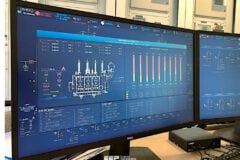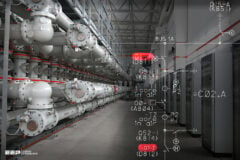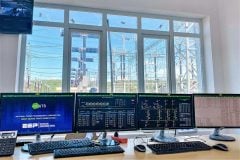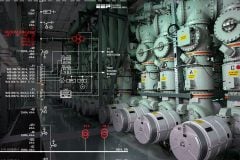
Continued from first part: Talking About HV Shunt Reactor Switching (part 1)
Content
- Scope (explained in previous part)
- Shunt reactors application (explained in previous part)
- Closing operation (explained in previous part)
- Opening operation
- Conclusions
Opening operation
In the case of shunt reactors the current to be interrupted are very low (typically less than few hundreds amperes) compared with the breaking capability of the circuit breakers: they are often referred to as “small inductive currents”.
After opening of the circuit breaker, the current flows through the arc between the contacts. This arc is stable at high currents, but in the case of small inductive currents it is not and it is very common that the current is interrupted prior to the natural current zero (current chopping).
The following picture shows a single-phase model of the system in subject, complete enough for the purposes of this paper.

Upstream the circuit breaker, the source side is represented by a sinusoidal voltage source:
![]()
being U the rated voltage of the system, including the reactor. Inductance and capacitance to ground of the source side of the system are represented by Ls and Cs respectively. The parallel capacitance Cp is a parameter of the circuit breaker. Normally Cs >> Cp. The reactor is represented by its inductance L, the stray capacitance CL and the inductance of its connections up to the circuit breaker Lb.
If the current interruption occurs at the passage for zero value of current, then CL is charged at the max voltage (being current lagged approximately 90° from voltage):

The parallel circuit CL // L starts oscillating at frequency ![]() and voltage does never exceeds the maximum system voltage.
and voltage does never exceeds the maximum system voltage.
Suppose the chopped current is Ich ≠ 0. The electrostatic energy stored in the capacitances is the same than in the previous case. But, additionally, electromagnetic energy is stored in the inductance:
![]()
The overall energy will swing forth and back in the following circuit:

Inductance Lb is negligible, and Cs>> Cp let us replace the series connected capacitance with Cp only. So inductance L is now in parallel with capacitance (Cp+ CL). The energy stored in the circuit is now:

The suppression peak overvoltage is reached as soon as the whole energy charges the capacitance (Cp+ CL):

In the hypothesis that Cs >> CL it can be written:
![]()
Where N is the number of interrupting chambers per pole. Chopping number λ is a characteristic of the circuit breaker and can be assumed to be a constant for different types of circuit breakers, except for vacuum circuit breakers.
Typical ranges of chopping numbers are:
| Circuit breaker type | Chopping number (λ) (AF0.5) |
| Minimum oil | 7 – 10 x 104 |
| Air blast | 15 – 24 x 104 |
| SF6 | 4 – 17 x 104 |
Considering that ![]() , expression (1) can be written in p.u. of max voltage
, expression (1) can be written in p.u. of max voltage ![]() :
:


The resonance frequency on reactor side is now ![]() (about 1÷5kHz).
(about 1÷5kHz).
On source side, with a sufficiently extended network Ls and Cs are high enough to say that there are negligible overvoltages and no oscillation: the network voltage can be assumed to stay constant at ![]() .
.
When the oscillating voltage on reactor reaches the opposite peak (after half a cycle), the consequent peak recovery voltage could exceed the dielectric withstand capability not yet fully recovered, so leading to reignition. A re-ignition will generate high-frequency transients, typically hundreds of kHz, in both the reactor voltage and the current through the circuit breaker.
In fact during re-ignition the oscillating circuit is given by:

The two capacitances discharge one on each other through the small inductance of connections with a frequency ![]() . Several consecutive ignition can occur, for the same reasons:
. Several consecutive ignition can occur, for the same reasons:

The interval between succeeding re-ignitions increases as a consequence of the progressively increased withstand capability of the insulating medium, each time able to withstand major recovery voltages.
The difference between source and load side voltages immediately before each re-ignition increases time by time and so the overshoots when re-ignition occurs. But the potential danger for the reactor actually comes from the steep voltage transient that is imposed on the reactor at each voltage breakdown associated to a re-ignition.
In fact steep front voltages may be unevenly distributed across the reactor winding, stressing the entrance turns in particular with high interturn overvoltages with consequent risk of winding insulation puncture.
Differently, the first suppression overvoltage is associated with relatively low frequencies, so the relevant voltage stress is evenly distributed and is somehow more acceptable.
Shunt reactors are normally protected by surge arresters, which will limit overvoltages to earth to acceptable levels. But arresters cannot reduce the steepness of the voltage swings associated with re-ignitions. Actually the way to effectively limit voltage stresses on reactors passes through avoiding re-ignition.
Conclusions
The target to reduce electrical stress and avoid harmful transients can be achieved by adopting the following measures:
Controlled opening device,
ensuring contacts separation early before current zero, so maximizing the arcing time and eliminating risk of re-ignition3; in addition to that, controlled closing can also be implemented to minimize inrush and zero sequence currents during energizing of shunt reactor; the controlled switching devices available on the market nowadays can perform both opening and closing controlled switching, which is a benefit for the reactor as well as the circuit breaker (maintenance intervals minimized);
Single-pole operated circuit breakers,
suitable forused with controlled switching devices. Mechanical endurance class M2 and electrical endurance class E2 are recommended, especially for frequently switched reactors (which is the case of shunt reactors associated to renewable power plants or to HVDC converters).
3 Contacts are not parted close to the instant of maximum phase-to-earth voltage, corresponding to the minimum of current, as one could expect, but around the instant when voltage is zero.
In this way the current is high enough to produce stable arc for a sufficient time letting the gap between contacts be large when the low current will be chopped. An optimal arcing time is in the range 4-7 ms.
Bibliography
- “Live Tank CB Application Guide” – ABB
- “Buyers Guide HV Live Tank Circuit Breakers Ed5 en” – ABB
- “Trasmissione e distribuzione dell’energia elettrica” – N. Faletti, P. Chizzolini
- “Switching Shunt Reactors” – Roy W Alexander, NeilA. McCord P.E.
- “HV shunt reactor secrets for protection engineers”- Zoran Gajić, Birger Hillström, Fahrudin Mekić











in real operation the Controlled opening relay may be out of adjustment or disabled so we return to the initial case of circuit breaker without relay, what to do in those cases? MOVs?, a CB with a higher rating?